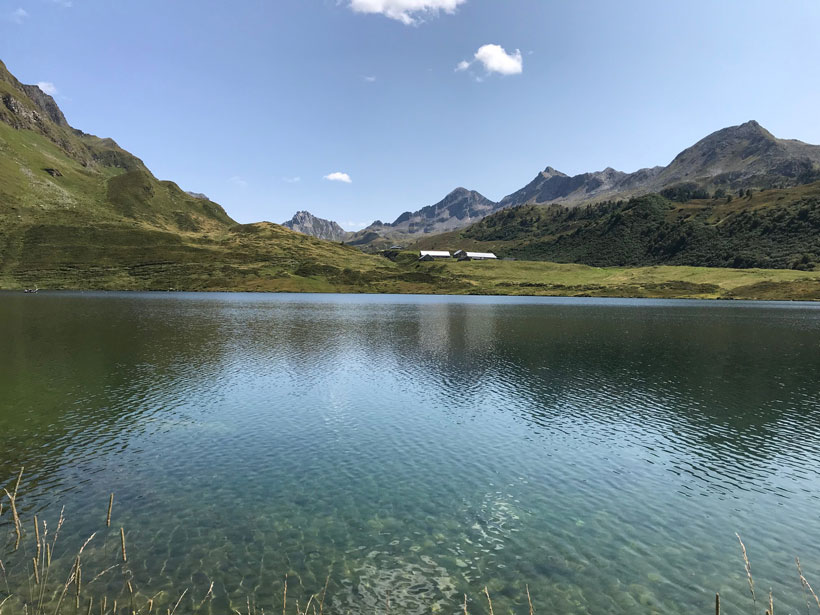All life needs nitrogen, but most organisms can use only nitrogen that has been “fixed,” or transformed into a biologically useful form by microbes. Biological nitrogen fixation was imperative to the expansion of life on early Earth, and a dearth of fixed nitrogen has even been invoked as an explanation for Earth’s “Boring Billion,” a 1-billion-year period in the Proterozoic when the expansion and evolution of life seem to have ground to a halt.
Cyanobacteria—commonly called blue-green algae—are often thought to have been the most important marine nitrogen fixers in the Proterozoic, as they are generally considered to be today. But a new discovery made in an alpine lake offers a window to Earth’s distant past, complicating that assumption.
Purple sulfur bacteria (PSB) in Proterozoic-analogue Lake Cadagno, Switzerland, can fix nitrogen at rates comparable to the low end achieved by cyanobacteria, according to researchers. This finding, published in a new study in Nature Communications, is the first time that PSB have been observed fixing nitrogen outside of a laboratory.
An Unexpected Discovery
PSB are anoxygenic phototrophs—photosynthetic organisms that don’t produce oxygen like plants and cyanobacteria do. Previously, researchers had discovered that different anoxic phototrophs called green sulfur bacteria could fix nitrogen in Lake Cadagno, but only at very low rates.
“It became very clear that the one organism that was previously shown to fix nitrogen in [the Lake Cadagno] ecosystem could not be responsible for the high rates that we measured.”
As part of a short field trip in 2018, Miriam Philippi, a biogeochemist from the Max Planck Institute for Marine Microbiology in Bremen, Germany, visited Lake Cadagno and had intended to simply double-check previous measurements of nitrogen fixation in the lake.
“We were not expecting to find what we actually found,” she said. The bacteria in her samples were fixing nitrogen much faster than the previously described green sulfur bacteria should have been able to. “It became very clear that the one organism that was previously shown to fix nitrogen in this ecosystem could not be responsible for the high rates that we measured,” she recalled.
Linking Nitrogen Fixation to Purple Sulfur Bacteria
The microbial community in Lake Cadagno is variable—it is sometimes dominated by green sulfur bacteria and sometimes by PSB. When Philippi visited, PSB were so abundant that they colored her water samples pink. Additionally, the genomes of PSB previously found in Lake Cadagno contained genes for nitrogenases, enzymes responsible for nitrogen fixation. But claiming that PSB were responsible for high nitrogen fixation rates would have been unprecedented.
“There was some indication that under in situ [natural] conditions, there is potential for purple sulfur bacteria to fix nitrogen,” said Katharina Kitzinger, also a biogeochemist from the Max Planck Institute for Marine Microbiology. But PSB had never actually been observed fixing nitrogen in a natural environment.
To conclusively link PSB to nitrogen fixation, Philippi, Kitzinger, and their colleagues combined multiple approaches. Using metatranscriptomics, they showed that the majority of nitrogenase gene expression in Lake Cadagno was tied to PSB. A different set of measurements showed that PSB could fix nitrogen much faster than other noncyanobacterial aquatic microbes.
“It’s a very beautiful environmental microbiology study showing very conclusively, I think, for the first time that it is the purple sulfur bacteria that are fixing a lot of nitrogen in a natural system,” said Jennifer Glass, a geobiologist from the Georgia Institute of Technology who was not involved in the research.
Implications for the Proterozoic Ocean
Discovering that PSB fix nitrogen in Lake Cadagno is significant because of the lake’s unusual, layered structure—it has a shallow oxygenated surface layer overlying sunlit sulfide-rich bottom waters where anoxygenic phototrophs can thrive. These characteristics are thought to mimic the ocean during the Proterozoic eon. And if PSB fix nitrogen in Lake Cadagno, they might have been important players in the Proterozoic nitrogen cycle, too. This challenges the assumption that cyanobacteria were the only dominant nitrogen fixers in the Proterozoic, which could have rippling implications for Earth’s past biogeochemical cycles.
“Just because a compound has a lower availability in terms of concentration doesn’t mean that microbes can’t make use of it.”
One possible limit on Proterozoic life could have been nitrogen because the most important nitrogenase enzymes contain molybdenum—an element that was likely scarce in the Proterozoic ocean. Lake Cadagno’s waters are likewise poor in molybdenum, but the PSB there could still fix nitrogen effectively. And although Kitzinger cautioned that it’s impossible to know exactly what the nitrogen cycle looked like in the past, the new result could indicate that nitrogen fixation might not have been as severely impeded by the Proterozoic molybdenum limitation as sometimes hypothesized.
“Microbes just find a way to function irrespective of the concentration,” Kitzinger said. “Just because a compound has a lower availability in terms of concentration doesn’t mean that microbes can’t make use of it.”
—Elise Cutts (@elisecutts), Science Writer

